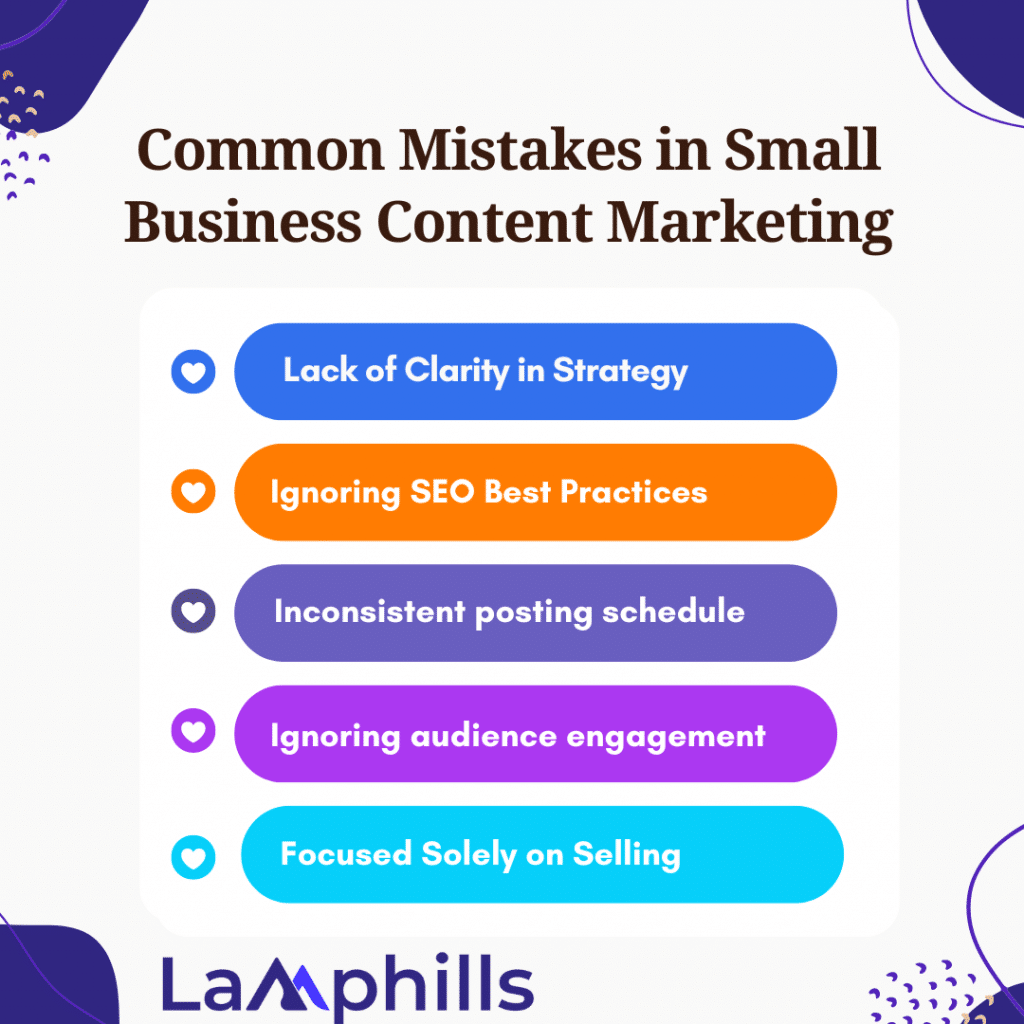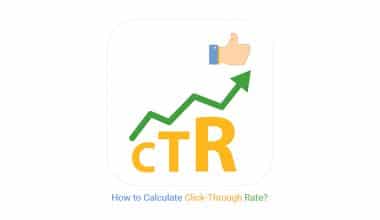If you own a small business, you should consider using content marketing to help it grow. Digital content is really significant. In reality, people spend approximately 7 hours every day consuming content online. I was overwhelmed by the amount of information available when I first started content marketing for my small business. Every blog and expert seemed to have a different strategy, and I found myself making a lot of mistakes that slowed my business’s growth. I didn’t realize the deadly mistakes I was making and how to correct them until I took a step back and examined my strategy. Allow me to share my experience, together with critical statistics and insights, to help you avoid these traps and thrive in your content marketing initiatives.
What is Content Marketing?
Simply put, content marketing is a strategy for developing, distributing, and sharing content with your target audience. To hold clients’ attention and meet their demands, the content should be valuable and relevant.
The goal of this marketing strategy is to establish authority in your sector while also increasing brand recognition (or interest in your product or service) in a digestible format.
Many of the mediums included in content marketing are undoubtedly recognizable to you. Examples include writing frequent blog articles, making tutorial-style YouTube videos, and providing visual content for your Instagram profile.
This marketing strategy has grown increasingly valuable in the digital age, as individuals consume more content online than ever before. Compared to more traditional kinds of marketing (such as a pop-up window or radio advertisement), content marketing is something that consumers choose to interact with because they find it useful or inspiring, and may even choose to share it with friends.
Key Takeaways
- A defined content marketing strategy is essential for effective and organized efforts.
- SEO is crucial for increasing visibility and driving organic traffic to your content.
- Regularly scheduled content helps build audience trust and engagement.
- Interacting with your audience fosters stronger relationships and loyalty.
- Provide valuable, informative content alongside promotional material to keep your audience engaged.
Types of Content Marketing
You can use a variety of content marketing forms to differentiate your business. The following are six of the most prevalent varieties, along with examples of how to use each in your own promotional efforts.
#1. Blog posts
A company blog can cover almost any topic, but with millions of blog-style websites available, choose a niche that isn’t overcrowded and aligns with your business objectives. A blog should be updated regularly with unique and captivating content that fulfills the demands of your target audience and, preferably, assists them in solving a problem.
For example, a tech site that features a new creator every week and provides insights and guidance to aspiring entrepreneurs.
#2. Social media posts
Social media channels such as Facebook, Instagram, Twitter, TikTok, and LinkedIn are excellent for publishing content that is more easily shared than traditional blog articles. However, each provides unique best practices, content formats, and audience demographics, so choose the channel(s) that best meet your business objectives.
For example, a LinkedIn article featuring an eye-catching infographic and suggestions from your company’s founder. Repurpose the infographic into an Instagram post that refers back to the original article.
#3. Video content
Creating video content does not have to drain your marketing budget. Videos might be short or long, shot on a smartphone for social media, or taken with a DSLR camera for your website or YouTube channel. In either case, the footage should be of good quality and include a narrative intended to entertain or educate.
For example, take a behind-the-scenes look at the manufacturing process for your goods. To maximize reach, publish the video on YouTube and embed it in a relevant blog article.
#4. Podcasts
This long-form audio content is often in the form of interviews, instructional talks, or nonfiction narratives. One of the most tempting parts of podcasting is the ability to listen online or on the move using a smartphone.
Consider a weekly series dedicated to refuting common misunderstandings in your profession, complete with hilarious tales and expert guests.
#5. Webinars
An online broadcast that is usually held live to deliver insightful and interesting content to your target audience. Seminars, panel discussions, and Q&As with a guest speaker are among the most common types.
For example, a virtual panel debate on a controversial topic in which attendees can express questions and interact with speakers.
#6. White papers and eBooks
These comprehensive guides enlighten readers on a more difficult topic, hence increasing their level of comprehension. Creating these data-backed reports can help your firm establish authority and build confidence with your audience.
For example, a research-backed document forecasts industry trends for the coming year.
No matter what content type you choose, be smart and build materials that can be used across various media. This will help you make the most of your time and money while prioritizing the demands of your clients.
Benefits of Content Marketing for a Small Business
Aside from boosting your marketing efforts, there are other obvious benefits to content marketing for a small business. This is how they are broken down.
#1. Make your business stand out
It might be difficult to stand out online. However, your content may take the lead by demonstrating your brand’s values, providing relevant information to your audience, and fostering a community around it.
#2. Create a brand
Whether you’re offering a product or a service, your brand is what leaves a lasting impact on your audience. You can get people talking about your business if you have a strong social and organic presence.
#3. Communicate with customers
Your blog, social media, and newsletter campaigns provide several touch points for your audience, giving you more possibilities to connect with them directly and produce leads.
#4. Attract organic website visits
Optimized website and blog content can provide targeted, long-term organic traffic for years after publication. Marketers may find themselves at the mercy of social media advertising platforms and variable prices. Gain longer-term value from high-performing organic content and reduce your reliance on advertisements.
Sugar Geek Show, an online cake decorating learning platform, for example, has made their free blog their most profitable revenue stream.
By focusing on SEO and employing Semrush, they were able to increase organic traffic by 269% between 2019 and 2021. Income increased steadily, and by 2021, the blog accounted for 60% of Sugar Geek Show’s earnings.
Common Mistakes in Small Business Content Marketing

Here are some crucial mistakes to avoid and effective solutions to help your content marketing efforts succeed.
#1. Lack of Clarity in Strategy
One of the most common mistakes small businesses make is going into content marketing without a clear strategy. It’s tempting to start developing content right away, but without a strategy, your efforts will be disorganized and unproductive.
According to the Content Marketing Institute, 63% of businesses lack a written content strategy.
I first made the error of uploading random blog posts and social media updates without a clear strategy. This lack of direction resulted in inconsistent messages and missed opportunities to successfully engage my target audience.
Solution: Create a complete content marketing strategy that includes your objectives, target audience, content types, and distribution channels. This will provide a clear direction for your content efforts.
#2. Ignoring SEO Best Practices
Search engine optimization (SEO) is critical for getting your content recognized, yet many small businesses ignore it. Even the best content can go unnoticed if it is not optimized properly.
BrightEdge claims that organic search accounts for 53% of all website traffic.
In the beginning, I didn’t pay much attention to SEO, believing it was too hard. However, when I began optimizing my content for search engines, I noticed a substantial boost in organic traffic and interaction.
Learn and apply SEO best practices such as keyword research, on-page optimization, and link building. Tools like Google Keyword Planner and Moz can make this process easier.
#3. Inconsistent posting schedule
Consistency is essential in content marketing, but many small businesses struggle to keep a regular posting schedule. This inconsistency might confuse your audience and stifle your progress.
According to HubSpot, firms that publish 16 or more blog articles per month receive 3.5 times more traffic than those that generate 0–4 posts per month.
I used to post inconsistently, which resulted in changing engagement levels. When I committed to a constant schedule, I saw a steady increase in traffic and audience involvement.
Solution: Make a content calendar to plan and schedule your posts in advance. This ensures that you stay consistent and structured.
#4. Ignoring audience engagement
Content marketing is more than simply providing content; it’s also about connecting with your target audience. Failure to reply to comments, emails, and criticism might leave your audience feeling ignored and undervalued.
According to Sprout Social, 89% of consumers will purchase from a business they follow on social media if the brand reacts to their messages.
Initially, I did not prioritize engaging with my audience, instead focusing primarily on content development. However, when I began connecting with my audience, replying to comments, and resolving their problems, I was able to strengthen relationships and boost brand loyalty.
Solution: Set aside time to interact with your audience through social media, your blog, and other channels. Respond to comments, and inquiries, and express gratitude for their support.
#5. Focused Solely on Selling
While the ultimate goal of content marketing is to increase sales, relying entirely on promotional content may alienate your audience. Content that simply promotes items or services may come across as disingenuous and too commercial.
According to Demand Metric, content marketing is 62% less expensive than traditional marketing and generates around three times as many leads.
I first made the mistake of writing very sales-focused content. It wasn’t until I began focusing on giving value through instructive and entertaining content that I noticed a huge boost in engagement and trust from my audience.
Solution: Balance your content by providing useful information, sharing stories, and addressing your audience’s concerns. Use the 80/20 rule: 80% of your content should be informational and interesting, with 20% being promotional.
Real-World Examples of Small Businesses Using Content Marketing
#1. Buffer: Consistent, Valuable Content
Buffer, a social media management software, bases its brand on providing constant and valuable content. Their blog contains a plethora of knowledge about social media tactics, supported by research and case studies.
Over 1 million visitors per month are made to Buffer’s blog, which generates considerable traffic and leads for their business.
By following Buffer’s lead and continuously producing quality content, I was able to position my business as an authority in my field and build a dedicated audience.
#2. Moz SEO and Community Engagement
Moz, an SEO software business, specializes in both content development and community involvement. Their blog and resource center offers detailed SEO instructions and tools, and their Q&A forum encourages active community participation.
Moz’s website traffic and community involvement help them generate leads and retain customers.
Implementing Moz’s SEO and community engagement strategy helped me increase my search rankings while also creating a community of engaged followers who interacted with my content regularly.
How to Execute a Successful Content Marketing Strategy
#1. Create a Content Marketing Plan
A content marketing plan template can help you arrange your strategy and ensure that you have covered all of the bases. This template should cover your objectives, target audience, content types, publishing schedule, and distribution channels.
Using a Content Marketing Plan Template can help you stay organized and focused on your goals.
Are you ready to take your content marketing to the next level? Download our content marketing plan template now and start crafting a strategy that drives results. This template will guide you through every step, ensuring you create a comprehensive plan tailored to your business needs. Don’t miss out on the opportunity to boost your brand’s visibility and engagement.
#2. Leverage Analytics
Analytic tools such as Google Analytics and social media insights can help you track the success of your content marketing campaigns. This data will assist you in understanding what works and what does not, allowing you to fine-tune your strategy.
According to HubSpot, companies that analyze ROI are 12 times more likely to succeed.
#3. Collaborate with influencers
Working with influencers can help you expand your reach and present your business to new consumers. Choose influencers who share your brand’s beliefs and actually connect with their audience.
According to TapInfluence, influencer marketing generates 11 times higher ROI than traditional types of digital marketing.
#4. Create evergreen content
Evergreen content retains relevance and value over time, resulting in consistent traffic and interaction. Create comprehensive guides, tutorials, and materials that answer frequent industry pain points and queries.
According to Ahrefs, 60% of the best-performing blog entries are more than two years old, demonstrating the value of evergreen content.
Conclusion
Content marketing for small businesses can be an effective growth strategy, but it demands a planned approach and a dedication to offering value. By avoiding these frequent mistakes and applying successful tactics, you may improve your content marketing efforts and achieve long-term success. What problems have you encountered during your content marketing journey, and how have you solved them? Please share your experiences and help us continue the discourse!
Related Articles
- B2B Content Marketing Services: Choosing the Right Fit for Your Business
- Key Tips To A Successful Partnership Announcement (Right Way to Make a Partnership Announcement)
- Top 10 Keyword Research Services in 2024
- Integrated Communication in the Digital Age
- 27 Overlooked Real Estate Content Marketing Ideas the Pros Don’t Want You to Know About






